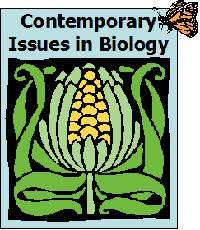
Week 12, Chapter 9 -- Digging Deeper
Course home | Weekly schedule | Announcements | Instructor Info | Desire2Learn | MasteringBiology® | Honor Code | FAQs | HELP!
 |
Week 12, Chapter 9 -- Digging DeeperCourse home | Weekly schedule | Announcements | Instructor Info | Desire2Learn | MasteringBiology® | Honor Code | FAQs | HELP! |
In this assignment, you will explore the link between genes and a specific disease in a little more detail than you did in the last Digging Deeper assignment. Remember, this stuff can get technical pretty quickly, so be sure to ask your instructor if you need help.
Part 1:
Go to the Genes and Disease page at NCBI (National Center for Biotechnology Information).
There you will find a list of body locations for identified genetic diseases. Browse around until you find a category that interests you. If you click on any of the body locations, you will see a general description of the body system.
Once you have selected a body system category, click on a specific disorder that interests you below the general description [anything except SCID, which is discussed in the chapter and the sample assignment]. You will see an explanation of the gene(s) that contribute to the disorder. The description may contain some technical language, but you should see some familiar terms from your previous readings on metabolism, cell structure, and genetics.
This screen also includes a list of several Links in the right navigation. I recommend these three:
(Optional: If you’re interested in evolution, you might also click on BLink, which shows similarities of your gene with related genes in other organisms, including archaea, bacteria, animals, fungi, plants, and viruses).
Part 2:
For your Digging Deeper assignment, answer the following questions in complete sentences about your chosen disorder:
Because of the technical language involved, this assignment may tempt you to “cut and paste” from other websites. Remember, that is plagiarism and an example of academic misconduct! You must learn to paraphrase, which means writing the ideas in your own words. If you need help with that, visit the site on Avoiding Plagiarism . And remember to correctly cite all references you used in creating your report.
You can view a sample assignment here.
Part 3:
Use D2L's spell checker (or the one on your word processor software, which will give you a word count as well). Proofread it yourself too, because spell checkers don't catch everything. When you are satisfied, post your completed assignment in the Digging Deeper forum for this week at the D2L discussion board.
Part 4:
Respond to at least two other students’ assignments. (If you are the first or second person to post, you will have to check back later to complete this part of the assignment). Your response should address whether you found the disease mechanism easy to understand from the author's description.
After you have posted your assignment AND responded to two other students, go to Desire2Learn and complete the Gradebook Declaration for this week's Digging Deeper assignment. (Your Gradebook Declaration is subject to the Honor Code.)
Here is the text of the Desire2Learn Gradebook Declaration: (8 points) I have posted my spell-checked, proofread Digging Deeper assignment
at D2L. My assignment contains all the components listed in the assignment
instructions. |